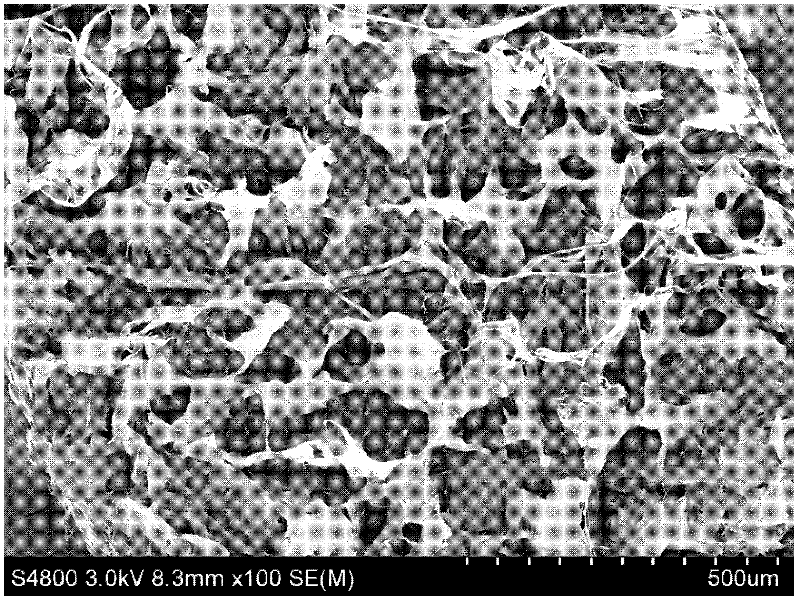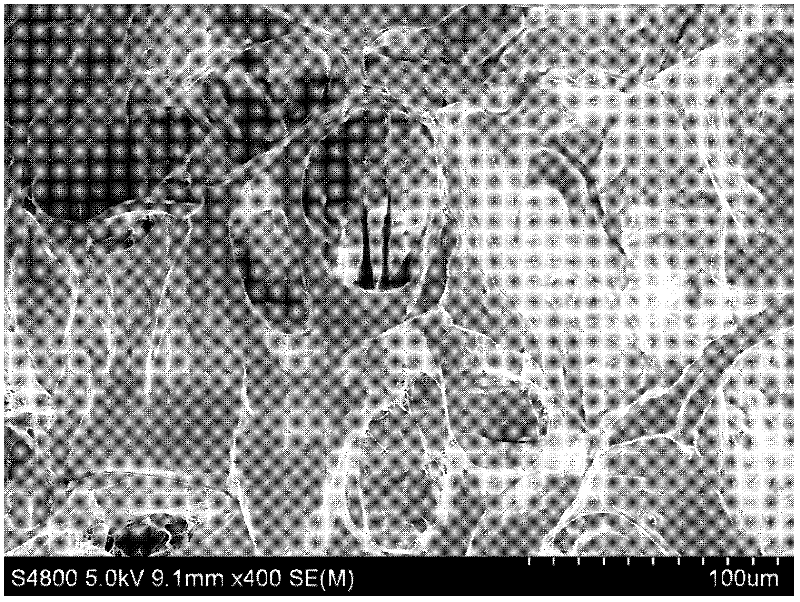A method for adjusting pores of porcine acellular dermal matrix for tissue engineering
An acellular dermis and tissue engineering technology, which is applied in the field of pore adjustment of porcine acellular dermal matrix for tissue engineering, can solve the problems of destroying the natural structure of collagen, reducing biocompatibility and mechanical properties, and high extraction cost, and achieves wide application. Prospect, important clinical application value and effect of social benefit
- Summary
- Abstract
- Description
- Claims
- Application Information
AI Technical Summary
Problems solved by technology
Method used
Image
Examples
Embodiment 1
[0023] Example 1: Preparation of PADM natural scaffold with a pore size of 100-150 microns.
[0024] (1) Weigh a certain amount of PADM, then immerse it in ultrapure water 120 times its weight, and fully wet the scaffold for 15 hours in a constant temperature shaker at a speed of 80 rpm.
[0025] (2) Accurately weigh 7% chitosan by weight and dissolve it in the water containing the bracket, and continue to react for 12 hours in a constant temperature shaker at a speed of 120 rpm.
[0026] (3) Take out the bracket, wash with deionized water 3 times, 60 minutes / time, and the shaking table speed during washing is 80 rpm.
[0027] (4) Freeze at minus 70°C, and finally freeze-dry at minus 60°C for 16 hours.
[0028] The PADM obtained after the above steps has a pore diameter of 100-150 microns and a pore wall thickness of 5-10 microns. The tissue engineering PADM is composed of fiber bundles.
Embodiment 2
[0029] Example 2: Preparation of PADM natural scaffold with a pore size of 150-300 microns.
[0030] With embodiment 1, the quality of water-soluble chitosan is 20% of PADM weight in the step (2);
[0031] Washing time 5 times in step (3).
[0032] The PADM obtained after the above steps has a pore size of 150-300 microns and a tissue engineering PADM whose pore walls are composed of 5-10 micron loose collagen sheets.
Embodiment 3
[0033] Example 3: Preparation of PADM natural scaffold with a pore size of 50-100 microns.
[0034] With embodiment 1, water-soluble chitosan is changed into sodium polyaspartate;
[0035] The quality of sodium polyaspartate in step (2) is 8% of PADM weight;
[0036] The PADM scaffold obtained after the above steps has a pore size of 50-100 microns, and the pore wall is composed of sheet-like collagen with a thickness of 30-50 microns.
PUM
| Property | Measurement | Unit |
|---|---|---|
| molecular weight | aaaaa | aaaaa |
| density | aaaaa | aaaaa |
| pore size | aaaaa | aaaaa |
Abstract
Description
Claims
Application Information
 Login to View More
Login to View More - R&D
- Intellectual Property
- Life Sciences
- Materials
- Tech Scout
- Unparalleled Data Quality
- Higher Quality Content
- 60% Fewer Hallucinations
Browse by: Latest US Patents, China's latest patents, Technical Efficacy Thesaurus, Application Domain, Technology Topic, Popular Technical Reports.
© 2025 PatSnap. All rights reserved.Legal|Privacy policy|Modern Slavery Act Transparency Statement|Sitemap|About US| Contact US: help@patsnap.com



